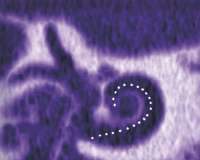Hearing through sight

Cochlear implants allow adults who have become profoundly deaf to recover the ability to understand speech. However, recovery differs between individuals. Activating the visual regions of the brain has proved essential to the satisfactory recovery of hearing, according to a new study by the Centre de Recherche Cerveau et Cognition (CERCO, CNRS/Université Toulouse III - Paul Sabatier), carried out in close collaboration with the ENT department at Hôpital Purpan in Toulouse. The more the area of the brain responsible for vision is activated immediately after implantation, the better the individual's speech understanding performance six months later. There is therefore a synergy between sight and hearing, resulting in a gradual improvement in the decoding of speech. These findings, which have just been published in Brain, illustrate the crucial role of brain plasticity. And they may make it possible to develop diagnostic tools for specific rehabilitation.
Cochlear implants are an effective alternative for people suffering from profound deafness (with a hearing threshold greater than 90 decibels) to emerge from a silent world. Implanted in the inner ear during a surgical procedure, these auditory neural prostheses transform external sounds into electrical impulses that directly stimulate the auditory nerve, leading to a marked recovery of hearing capacity. On average, people who, after becoming deaf, could only recognize one in five words before implantation are able to distinguish more than 80% of words afterwards. However, the degree of recovery may vary on an individual basis.
What is the origin of this disparity? The signal delivered by the implant is significantly degraded, thus obliging patients to develop adaptive strategies. Their performance will therefore depend on how their brain adapts in order to decode the signal. The CERCO scientists estimated that the brain's capacity for plasticity may play a fundamental role in the success of rehabilitation using a cochlear implant. To support this hypothesis, they wondered whether it was possible to identify the brain regions whose activation is essential to a good recovery, as well as predict the potential for recovery of patients, based on the state of activity of these regions at the time of implantation.
Their study concerned 10 patients who had become deaf in adulthood after language acquisition, and who had recently received an implant. The scientists performed a PET (positron emission tomography) brain imaging session immediately after insertion of the implant: they then recorded the level of activation in each region of the brain during a simple test (which involved identifying whether the "sound" perceived was a word or not). Six months later, the research team measured the degree of recovery of the same patients using more elaborate word recognition tests. The final stage consisted in drawing a correlation diagram for each brain region under study. The researchers thus evidenced two types of brain regions. The first group notably included the visual cortex and prefrontal cortex, which are associated with language learning and production: the greater the activation of these regions at the time of implantation, the higher the degree of recovery six months later.
Surprisingly, the brain regions processing visual information were thus correlated to auditory rehabilitation. Thus, the stronger the activation in patients' visual cortex at the time of implantation, the better they could understand speech six months later. According to the scientists, this result was linked to the fundamental role of lip reading in auditory speech recovery. Vision thus supplies additional information that is crucial to understanding language, particularly in noisy environments where patients with cochlear implants sometimes find it difficult to distinguish words. Sight and hearing act together and in total synergy, thus helping to gradually improve patients' ability, as they recover, to decipher the words coded by the implant.
These results highlight the crucial role of brain plasticity in implanted patients. This role could also be key in any other rehabilitation mechanism using a neural prosthesis (affecting vision or motor functions, for example). In addition, these findings could make it possible to predict the level of recovery that an implanted patient will achieve. Based on objective brain imaging data, it may be possible to implement individual, more or less intensive speech therapy rehabilitation, relying on an adapted strategy aimed at familiarizing each patient with the implant (hearing, lip reading and/or visual-auditory interactions). The efficacy of this type of targeted rehabilitation should help rationalize the cost of caring for these patients.
More information: "Visual activity predicts auditory recovery from deafness after adult cochlear implantation." Kuzma Strelnikov, Julien Rouger, Jean-François Demonet, Sebastien Lagleyre, Bernard Fraysse, Olivier Deguine and Pascal Barone. Brain (2013). Published online on October 17, 2013 and in print in December 2013. DOI: 10.1093/brain/awt274


















